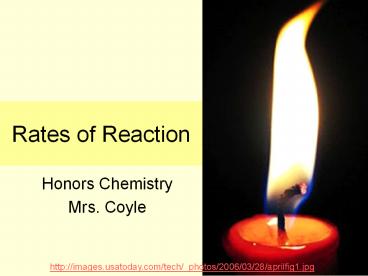Rates of Reaction - PowerPoint PPT Presentation
Title:
Rates of Reaction
Description:
... Chemistry. Mrs. Coyle. http://images.usatoday.com/tech/_photos/2006/03/28/aprilfig1.jpg ... http://content.answers.com/main/content/wp/en/thumb/f/ff/525px ... – PowerPoint PPT presentation
Number of Views:25
Avg rating:3.0/5.0
Title: Rates of Reaction
1
Rates of Reaction
- Honors Chemistry
- Mrs. Coyle
http//images.usatoday.com/tech/_photos/2006/03/28
/aprilfig1.jpg
2
How fast do reactions occur?
http//www.ging-strategie.de/Anti20Aging20Strate
gie.JPG
3
Reaction Rate
- The change in concentration of a reactant or a
product per unit time. - Rate At2-At1 Rate ?A
- t2-t1 ?t
- Brackets indicate concentration.
- Units mol / L / s
- or mol/(Ls)
4
Exo- and Endothermic Reactions
- Exothermic reaction reaction gives off energy.
- reactants products
energy - Endothermic reaction reaction takes in energy.
- energy reactants
products
5
Bonds and Energy
- When bonds are broken energy is absorbed.
- (analogy stretching a rubber band)
- When bonds are formed energy is released.
- (analogy releasing a stretched rubber band)
6
Average bond energies, kcal/mole Average bond energies, kcal/mole
C-H 98
O-H 110
C-C 80
C-O 78
H-H 103
C-N 65
OO 116
CO 187
CC 145
( as found in CO2) ( as found in CO2)
7
Ex Exothermic
- H2 Cl2 ? 2 HCl 183 kJ/mol
8
Ex Endothermic
- 2HgO 181.7 kJ ? 2Hg O2
9
Net Energy Change
- DH Potential Energy of Products
- -Potential Energy of Reactants
- DH lt0 exothermic
- DH gt0 endothermic
10
Collision Theory of Reactions
Molecules must collide in order to react.
http//staff.um.edu.mt/jgri1/teaching/che2372/note
s/10/10_19.gif
11
Collision Theory Contd
- Molecules have kinetic energy before the
collision. The KE is changed to potential energy
as the bonds are breaking and new bonds are
forming.
12
Collision Theory Contd
- Activation energy is the minimum amount
(threshold) of kinetic energy the reactants must
have in order to react. - The particles form an activated complex
(transition state) that is an unstable
arrangement of atoms that lasts a few moments. - The products are formed.
13
Analogy
http//www.800mainstreet.com/7/0007-004-reac_rate2
.htm
14
(No Transcript)
15
- Potential Energy vs Time
- (Exothermic)
Heat of Reaction DH
Time
http//staff.um.edu.mt/jgri1/teaching/che2372/note
s/10/theory.html
16
Energy vs Time (Endothermic)
Activation Energy
Heat of Reaction DH
17
Reaction Rates are affected by
- Nature of the Reactants
- Concentration
- Temperature
- Catalyst
- Surface Area (Particle Size)
- Mixing (Stirring)
18
Effect of Nature of Reactants on Reaction Rate
- Ionic reactions usually occur faster than
reactions involving transfer of electrons.
19
Concentration Effect on Reaction Rates
The more concentrated, the higher the reaction
rate. Why?
http//content.answers.com/main/content/wp/en/thum
b/f/ff/525px-Molecular-collisions.jpg
20
Rate Expression
- Rate k Ax By
- k is the specific rate constant.
- The exponents and k are determined from
experimental data.
21
Homogeneous and Heterogeneous Reactions
- Homogeneous reactants are in the same phase.
- Heterogeneous reactants are in different phases.
22
Ex H2(g)I2(g)?2HI(g)
- Homogeneous
- Gas phase
- What effect would increasing the pressure have?
23
Ex Zinc(s) Sulfuric Acid (aq)
- Heterogeneous.
- Increasing the surface area will increase the
reaction rate.
24
Temperature Effect on Reaction Rates
The higher the temperature, the faster the
rate. Why?
25
Catalysts
- A substance that speeds up the reaction without
being consumed.
26
Catalyst Effect on Reaction Rates
A catalyst lowers the activation energy, thus the
reaction proceeds faster.
27
Catalysts
- Homogeneous catalyst is in the same phase as the
reactants. - Heterogeneous catalyst is in a different phase
than the reactants. Provide a surface for the
reaction to occur.
28
Inhibitors
- Substances that negate the effect of the catalyst.
29
Particle Size (Surface Area) Effect on Reaction
Rates
- The smaller the particle size the faster the rate.
30
Effect of Mixing on Reaction Rates































